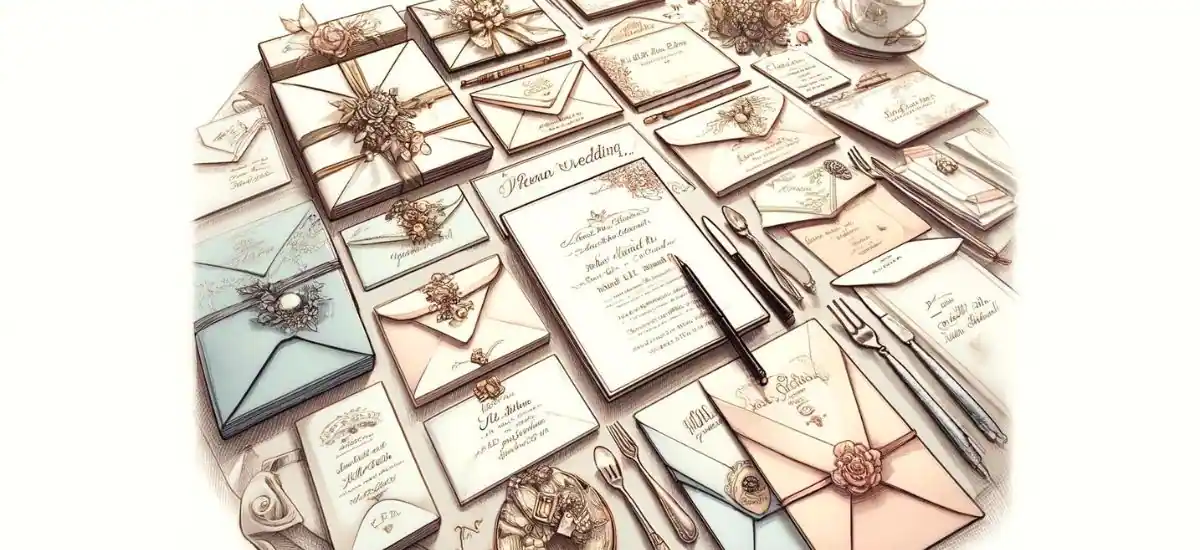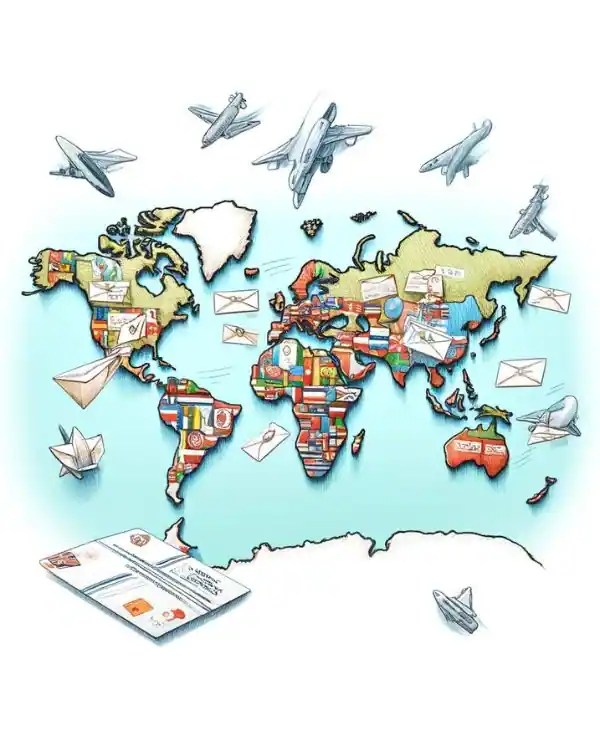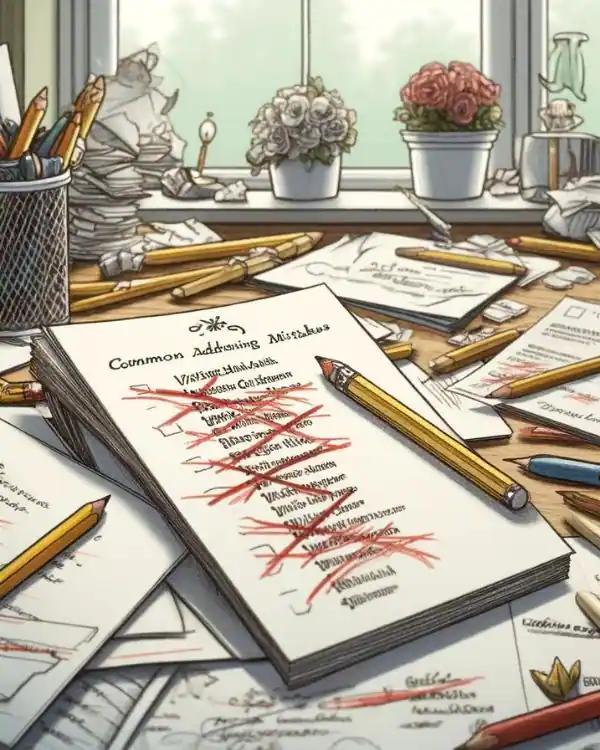Advertisement
By IS Team
How To Address Wedding Invitations Correctly: A Step-by-Step Guide

Advertisement
Properly addressing wedding invitations involves understanding and applying key etiquette principles. Start by using formal titles and full names to set the right tone for your event. For example, address single guests as " Mr. John Doe" or " Ms. Jane Smith".
For couples, include both names, such as " Mr. and Mrs. John Smith" for married couples with the same last name, or " Mrs. Jane Doe and Mr. John Smith" for those with different last names.
Including children on the inner envelope, like "John, Jane, Michael, and Lisa", adds a personal touch. By following these steps, you'll ensure your invitations are respectful, accurate, and elegant, leaving a lasting positive impression on your guests. 💌
Essential Etiquette for Addressing Wedding Invitations

Importance of Tone and Formality
The tone and formality of your wedding invitations set the stage for the event. It's crucial to match the addressing style with the nature of the occasion. For a formal affair, address guests with full names and titles, such as "Mr. Theodore Lau," while a casual event might use "Teddy Lau." This ensures guests understand the expectations and ambiance of your wedding.
Decoding the Parts of a Wedding Invitation Envelope
- Outer Envelope: Displays the guest's full name and address with formal titles. This is the first impression of your wedding's formality.
- Inner Envelope: More informal, it might list first names or include family members, like "John and Jane, Michael, and Lisa."
Understanding and respecting these elements reinforces traditional wedding etiquette and enhances the invitation experience.
Addressing Invitations to Individuals
How to Address Single Guests
When addressing invitations to single guests, it's important to use formal titles such as "Mr.," "Ms.," or "Miss." This not only shows respect but also maintains the formality of your event. For example:
- " Mr. John Doe"
- " Ms. Jane Smith"
Titles and Professional Designations
For guests with professional titles, it’s crucial to address them correctly to honor their achievements and status. Use their full title followed by their name, such as:
- "Dr. Emily Clark" for a medical doctor
- "Professor Henry Thompson" for an academic
Addressing Invitations to Individuals with Distinguished Titles
When addressing invitations to individuals with distinguished titles, such as doctors, judges, or military personnel, be sure to use their official titles. This shows a high level of respect and attention to detail. Examples include:
- "The Honorable Judge Mary Brown" for a judge
- "Captain Robert Lee" for a military officer
- "Dr. Samantha Green" for a medical doctor
Using correct titles and designations not only honors your guests but also upholds the formal tone of your wedding invitations.
Addressing Invitations to Couples

Married Couples with the Same Last Name
When addressing married couples who share the same last name, the traditional format is to include both titles and the husband’s full name. This approach reflects classic etiquette and formality:
- "Mr. and Mrs. John Smith"
Married Couples with Different Last Names
For married couples who have different last names, it’s respectful to include both full names, often listing the wife’s name first:
- "Mrs. Jane Doe and Mr. John Smith"
Unmarried Couples Living Together
When addressing unmarried couples living together, list their names on separate lines, ensuring each person feels equally recognized. The names should be ordered alphabetically by last name:
- "Ms. Emily Davis"
- "Mr. Michael Brown"
Same-Sex Couples
For same-sex couples, use the same principles as for any couple, ensuring to include both names and titles. The order can be based on alphabetical order or personal preference:
- "Mr. James Anderson and Mr. Robert Harris" for a male couple
- "Mrs. Sarah Thompson and Mrs. Emma White" for a female couple
Addressing couples correctly shows your respect and attention to detail, setting a positive and inclusive tone for your wedding event.
Addressing Invitations to Families
How to Include Children on Invitations
When inviting families with children under 18, include the children's names on the inner envelope to ensure they feel included and welcomed. This also maintains a personal touch. For example:
- Outer Envelope: "Mr. and Mrs. John Smith"
- Inner Envelope: "John, Jane, Michael, and Lisa"
Alternatively, you can use "and Family" on the outer envelope for a more inclusive yet formal approach:
- "Mr. and Mrs. John Smith and Family"
Addressing Families with Children Over 18
For families with children over 18, it's proper etiquette to send separate invitations to the adult children, even if they live at the same address. This shows respect for their independence and acknowledges their adulthood. For example:
- Parents' Invitation: "Mr. and Mrs. John Smith"
- Adult Child's Invitation: "Ms. Lisa Smith"
Using these methods ensures that every family member feels individually recognized and respected, enhancing the overall guest experience.
Special Circumstances

How to Address Invitations to Widows and Widowers
When addressing invitations to widows, it’s respectful to use their late husband's name, unless you know they prefer to be addressed differently. This shows consideration and sensitivity. For example:
- "Mrs. John Smith"
For widowers, you can address them using their title and full name:
- "Mr. Thomas Brown"
Addressing Divorced Individuals
When addressing divorced individuals, use their preferred title and last name. If they have reverted to their maiden name, be sure to use it. This respects their personal preferences:
- For a woman who kept her married name: "Ms. Jane Smith"
- For a woman who reverted to her maiden name: "Ms. Jane Doe"
Inviting Cohabiting Couples
For couples living together but not married, address the invitation to both individuals by their full names, listed on separate lines. This approach is both inclusive and respectful:
- "Ms. Emily Davis"
- "Mr. Michael Brown"
Invitations to Guests with Significant Others
If you’re aware that a guest is bringing a significant other, it’s courteous to include their name on the invitation. This ensures that both individuals feel welcome and acknowledged:
- "Ms. Laura Williams and Mr. David Johnson"
By addressing these special circumstances with care, you demonstrate thoughtfulness and attention to detail, making each guest feel valued and respected.
Cultural Considerations

Addressing Invitations in Different Cultures
When addressing invitations across different cultures, it’s crucial to understand and respect cultural norms and traditions. This shows a deep level of respect and thoughtfulness towards your guests. For example:
- In many Asian cultures, the family name is placed before the given name. Address a Chinese guest as "Mr. Li Wei" rather than "Mr. Wei Li."
- For Indian guests, including honorifics and family titles can be important, such as "Dr. and Mrs. Ravi Patel".
Honoring Traditional Titles and Forms of Address
Honoring traditional titles and forms of address is essential in demonstrating cultural sensitivity. This includes understanding the correct usage of titles and the proper order of names:
- In many European countries, noble titles should be used correctly, such as "Sir John Davies" or "Dame Ellen Thompson".
- In Middle Eastern cultures, it’s respectful to include family titles, like "Sheikh Omar Al-Khalifa".
By incorporating these cultural considerations, you not only show respect for your guests' backgrounds but also enhance the overall grace and formality of your wedding invitations.
Formatting and Layout Tips
Proper Placement of Names and Addresses on the Envelope
The proper placement of names and addresses on the envelope is crucial for maintaining a polished and elegant look. Here’s the standard format:
- Recipient's Name: Centered on the envelope, using formal titles and full names.
- Street Address: Placed directly below the recipient's name.
- City, State, and Zip Code: Listed on the next line, ensuring clear and legible formatting.
- For example:
Mr. and Mrs. John Smith
123 Elm Street
Springfield, IL 62704
Use of Inner and Outer Envelopes
Using both inner and outer envelopes adds a layer of formality and protection to your wedding invitations:
- Outer Envelope: This is the main envelope that carries the invitation through the mail. It includes the full address and formal titles.
- Inner Envelope: This envelope holds the actual invitation and can be more informal. It might list the recipients by first names or include children’s names. For instance:
- Outer Envelope: "Mr. and Mrs. John Smith"
- Inner Envelope: "John, Jane, Michael, and Lisa"
Font and Script Style Suggestions
Choosing the right font and script style is key to creating a cohesive and stylish invitation suite:
- Legibility is paramount. Choose fonts that are easy to read while reflecting the formality of your event.
- Script Fonts: Ideal for a classic and elegant look. Examples include Edwardian Script, Bickham Script, or Copperplate.
- Modern Fonts: For a contemporary feel, consider sans-serif fonts like Helvetica, Futura, or Avenir.
- Combine styles for contrast: Use a script font for names and a simple, clean font for addresses.
By paying attention to these formatting and layout tips, your wedding invitations will not only look beautiful but will also convey a sense of care and thoughtfulness to your guests.
Common Mistakes to Avoid

Common Errors in Addressing Wedding Invitations
Addressing wedding invitations can be tricky, and even small mistakes can detract from the elegance and formality of your event. Here are some common errors to watch out for:
- Incorrect Titles: Using the wrong title, such as "Ms." instead of "Mrs.," can be seen as disrespectful.
- Misspelled Names: A misspelled name can make a guest feel unimportant and overlooked.
- Incomplete Addresses: Missing details like apartment numbers or ZIP codes can cause delivery issues.
- Informal Nicknames: Avoid using nicknames unless the guest specifically prefers it. Stick to formal names and titles.
Tips to Ensure Accuracy and Appropriateness
To ensure your wedding invitations are addressed accurately and appropriately, follow these tips:
- Double-Check Titles and Spelling: Verify the correct titles and spellings of your guests’ names. Taking the time to get this right shows respect and attention to detail.
- Use a Guest List Spreadsheet: Keep an organized spreadsheet of your guest list, including full names, addresses, and titles. This helps maintain consistency and accuracy.
- Consult with Guests: If you’re unsure about someone’s title or preferred name, don’t hesitate to ask them directly. It’s better to clarify than to assume and get it wrong.
- Review Postal Guidelines: Ensure your addresses comply with postal guidelines to avoid delivery issues. This includes checking for complete addresses with all necessary details.
- Proofread Multiple Times: Before sending out your invitations, proofread them multiple times. It can also help to have another person review them to catch any mistakes you might have missed.
By avoiding common errors and following these tips, you’ll ensure that your wedding invitations are accurate, appropriate, and elegantly presented, leaving a positive impression on your guests.
Frequently Asked Questions
Q1: How do I address wedding invitations to doctors who are married to each other?
When both individuals are doctors, you can address the invitation as "The Doctors Smith" or "Drs. John and Jane Smith" for a formal yet straightforward approach.
Q2: How should I address an invitation to a family with a hyphenated last name?
Address the envelope using both parts of the hyphenated last name, such as "Mr. and Mrs. John Doe-Smith" to ensure respect and accuracy.
Q3: Can I use printed labels for addressing wedding invitations?
While printed labels are convenient, handwritten addresses are preferred for a more personal and traditional touch, reflecting the care you put into your wedding preparations.
Q4: How do I address invitations to international guests? For international guests, include the full international address, ensuring to follow the recipient’s country’s format and adding the appropriate postage and customs details to avoid delivery issues
Advertisement
I'm Looking For!




.png)
.png)
.png)

